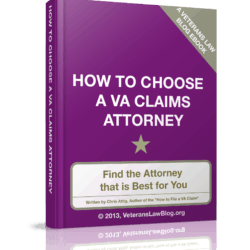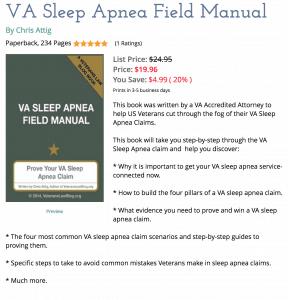On the Veterans Law Blog, I’ve talked a lot about how Veterans Court cases can be a blueprint – or a guide – to improving your own VA Claim.
Here are some of the things that the Veterans Court teaches us in our VA Claims:
1) How to know what GOOD Lay Evidence looks like.
2) 4 POWERFUL Ways to Improve your VA Claim
3) 6 Ways to Challenge a Compensation and Pension Exam opinion.
4) The ONE Thing you should do NOW in your VA Claim – before its too late.
5) 10 Cases Every Veteran Should Know.
How many ways can you use decisions from the Court of Appeals for Veterans Claims?
The United States Court of Appeals for Veterans Claims is a federal appellate court that, along with its reviewing court the United States Court of Appeals for the Federal Circuit, exercises judicial review over the Board of Veterans Appeals.
The Court has exclusive jurisdiction to review final BVA decision. Exclusive jurisdiction means that they are the only federal appellate court that can review BVA decisions. Those BVA decisions can be decisions appealed through the Legacy appeals process or the AMA appeals process.
Here are a couple ways you can use decisions of the Veterans Court (also known as the CAVC).
First, while you can only cite to Federal Circuit court cases and full-court Veterans Court opinions as binding legal precedent, you can use the lessons these cases teach us – anytime and anywhere. If we study the reasons that the Veterans Court grant and denies relief in any case, or a series of similar cases, we can get a sense of the mistakes we want to avoid in our own claims and appeals. And sometimes, we see rules of law that only apply to narrow fact patterns, but that we might be able to use because of the factual similarity of our own case.
Second, you can use memorandum and panel decisions from the Veterans Court to make sure you have the three types of evidence you need to give to the VA or BVA before the record closes in your claims and appeals.
Third, you can use them to get a sense for what motivates different firms and lawyers who represents veterans at the Courts.
Some attorneys use CAVC appeals as “lead generators.” That is to say, they take a whole bunch of CAVC appeals, push them through the system as fast as they can, plead low EAJA fees (if they seek any at all) and represent veterans in the really big effective date remands before the BVA or the AOJ.
Other attorneys represent only their own agency clients.
And others still tend to brief more cases to the Court, suggestion that they are working to change the law in some direction. My own firm is always on the lookout for fact patterns that allow us to challenge the Courts to read more statutes and regulations in a pro-veteran way.
And fourth, if you appeal to the Veterans Court in your own case, you can use cases with similar facts to argue that you should get the same (favorable) treatment at the CAVC.
But to use Veterans Court cases in that fourth way, you need to first appeal to the Veterans Court.
How do you appeal to the Veterans Court?
[CAVEAT: The following information focuses on how to get direct review of adverse BVA decisions. The Veterans Court can hear petitions for writs of mandamus, and has jurisdiction to address class action complaints, and the procedures and requirements of those types of appeals have different elements that you need to establish.]
As with all things related to VA disability, the rules seem straightforward and simple, but are anything but simple practice. One of the most important things to know, first, is that the Veterans Court is not part of the Department of Veterans Affairs.
The one nice thing about appealing to the Veterans Court – the changeover from the Legacy Appeals Process to the AMA Appeals Process at the BVA did NOT change the Court’s filing rules and requirements.
(Although the Court, in 2021, did make the surprising finding that the AMA rules Congress wrote for the BVA limit what the Court can do in providing relief to veterans).
Nevertheless, the easy answer to the question above is that to get your appeal heard before the Court of Appeals for Veterans Claims, you need to do three things: appeal a BVA decision within the Court’s jurisdiction, timely file your appeal (with exceptions) and file the appeal using the right forms.
Let’s tackle those one-by-one.
#1: The Veteran must have a Final BVA decision.
First, the Court must have jurisdiction over the BVA decision you are appealing. Jurisdiction is a legal concept which defines what the Court has the authority to do – from the types of appeals it can hear to the types of relief it can grant.
Currently, the only jurisdictional requirement for the CAVC to review a BVA decision is that the decision must be “final.”
A final BVA decision is one which grants or denies the appropriate relief. That phrase is important because when the BVA remands an appeal to the VA regional offices (now known as the Agency of Original Jurisdiction or AOJ), the Federal Circuit has said that it is not granting or denying the appropriate relief – only delaying that action a bit so the BVA or VA can gather additional evidence or follow the law, fair procedure, and due process before they issue a final BVA decision.
That said, there is a line of cases at the Federal Circuit that explain the very narrow and rare situations where that court can review Veterans Court remands, and that line of cases has been followed by the Veterans Court. I don’t see it as an issue of great importance to most veterans, but if you are an attorney or advocate who wants to study the issue, you can read more at Williams v. Principi, 275 F.3d 1361, 1363 (Fed. Cir. 2002).
Some BVA decisions include multiple forms of relief – some grant a claim, deny a claim and remand a claim all in the same BVA decision. When that happens, the issues that were not remanded are appealable to the CAVC.
Even still, when a BVA decision partially remands and partially denies a claim, the CAVC can still refuse jurisdiction on the grounds that the issues are “inextricably intertwined” and the resolution of the remanded issue might eliminate any need for the Court to review the issue that was denied.
A common example of this scenario occurs when a veteran’s survivor files for DIC and Accrued Benefits. If the accrued benefits claim is remanded, and the DIC claim denied, because the outcome of the accrued benefits could affect the denied DIC claim, the Court will often refuse to exercise its jurisdiction over the denied portion unless the need arises after the accrued benefits claim is resolved.
See what I mean? That single thing you need to show to get in order for the Veterans Court to review your BVA decision – a final BVA decision – has become rather complex, hasn’t it? THat’s one reason I feel strongly that veterans appearing before the Veterans Court hire a law firm with experience handling Court appeals. The Court process, the rules, and the law make it very easy for the pro-se veteran to step into a minefield that they cannot get out of.
Heck, I even recommend that most attorneys work with a law firm with an established Veterans Court practice – nobody can be a jack of all trades, and that it particularly true of attorneys who represent veterans. The Court process and the AMA claims and appeals process, both at the AOJ and before the BVA, are so very different that an attorney’s experience at the CAVC is a major strategic and tactical advantage for veterans and survivors appealing to the Court.
Annual and Monthly Subscribers to the Veterans Law Blog® get FREE access to all of our video courses and eBooks, like this course on navigating the AMA claims and appeals process.
So, let’s say you’ve cleared the jurisdictional hurdle, what do you have to do next to get the Veterans Court to hear your appeal?
#2: The Veteran must file their appeal – on time – to the Veterans Court.
The Veteran must file the appeal within 120 days of the date that the BVA mailed its decision (this date is usually referenced in the cover letter to the BVA Decision). This action starts a chain of events into action which include a Court order to the VA to serve a copy of the Record Before the Agency on the appellant and his/her representative.
I strongly recommend filing the Veterans Court Appeal before the 120 day deadline.
However, circumstances arise where it will be necessary to file at or near the 120 day deadline. In those cases, you are going to want to make sure that you are prepared to show that you timeline filed the appeal.
Now, if during those 120 days you file a motion for the BVA to reconsider its decision, then you will get another 120 days to file your appeal to the Veterans Court.
What if, on the other hand, you miss the deadline to file the BVA appeal? I have three things to say about that.
First, make sure that you truly missed the deadline. Many a veteran has failed to appeal a BVA decision because they miscalculated the deadline to file the appeal and though they had already missed it. If you hire a law firm to represent you at the Veterans Court, you don’t have to worry about this – your attorney is going to file your appeal on time and, if they don’t, then you might have a malpractice claim against the attorney.
Second, if you truly missed the deadline, ask yourself if any of these exceptional circumstances exist: (1) a mental health illness rendering one incapable of handling one’s own affairs or other extraordinary circumstances beyond one’s control, (2) reliance on the incorrect statement of a Veterans Administration official, or (3) a misfiling at the regional office or the Board of Veterans’ Appeals. If so, you may be able to get the deadline to file the CAVC Notice of Appeal waived so that you can file the appeal after the deadline has passed. Practitioners can look at cases like Bove v. Shinseki, 25 Vet. APp. 136 (2011) (per curiam order) and Bailey v. West, 160 F.3d 1360 (Fed. Cir. 1998) (en banc) to better understand how to establish equitable tolling.
For over a decade, there has been a push-pull between the Veterans Court and Federal Circuit. The CAVC tends to be very stingy with equitable tolling, and the Federal Circuit reminds them to loosen their standards up and extend equitable tolling to broader fact patterns. If the Veterans Court denies your appeal on the grounds that they refuse to equitably toll the deadline, you might – and I stress might – be able to appeal the Federal Circuit.
Third, even if you really miss the deadline and even if you cannot establish the basis for equitable tolling, there may be one other way to get your case before the CAVC. The Veterans’ Court’s rules require the Secretary to file a Motion to Dismiss no later than the 45th day after they serve the BVA decision on the appellant and the Court. If they miss that deadline, then the Court can and does hear the decision anyway.
Let me tell you a story about this rule that happened in 2021. My law firm was helping another lawyer raise a hyper-technical issue of law involving the timeliness of certain appeals that arose from a very old BVA decision. We filed the appeal on the reconsideration decision, and waited for the Secretary to move to dismiss the appeal as untimely. They never did. Not for a very long time after the BVA decision was served. And because they missed their deadline – a development we did not expect – we were able to object to their motion to dismiss as untimely and the CAVC agreed. The Veterans Court will review the 2014 decision as if it were issued by the BVA decision in 2021 because of the VA Secretary’s failure to timely move the Court to dismiss the appeal.
Now that’s a rare situation, but it can be done, and there is nothing wrong with doing so. The effect of this Court rule is to force the Secretary to take ownership of what BVA decisions the Court reviews, instead of requiring the Court adjudicate motions to dismiss, sometimes raised late in the litigation.
#3: File a proper Notice of Appeal (NOA) (and pay the filing fee).
The easy way to do this is to use the Notice of Appeal form on the CAVC website. However, if a Veteran does not use the NOA form, (s)he must meet the following elements in their notice of appeal:
– The name, address, phone number of the Veteran and the appropriate VA Claims file number
– Reasonable identification of the Board Decision being appealed from, and reasonably signal an intent to seek CAVC review of that decision
– Notice of Appearance filed by any representative entering their appearance in the case on behalf of the Veteran.
The Veterans Court allows for electronic filing of appeals – so follow the Court’s rules on how to do that. And if you are pro se, call the Court after and ask if you properly filed the appeal.
But if you do file the CAVC Notice of Appeal by mail, I recommend that you hold on to some evidence demonstrating that the Notice of Appeal was properly addressed, stamped and mailed in time to reach the Veterans Court in the normal course of business before the 120 day deadline has elapsed.
Here are some ways to do that. The last one on the list is a “Hail Mary” – it is not entirely clear if the Veterans Court would accept that as evidence of a timely filing.
- Send it certified mail return receipt requested.
- Fax the Notice of Appeal to the Court.
- Snap a “photo” of the envelope after the Post Office has affixed postage.
What’s the “Big Takeaway”?
If you have a BVA decision that denied a benefit, one of the smartest tactical steps you can take is to hire an attorney to represent you before the Veterans Court.
Statistics have shown that Veterans represented by attorneys have a greater likelihood of getting their claims remanded back to the BVA or Regional Office to correct errors that might be causing a negative outcome for the Veteran.
Hiring an attorney can – and should – be a big deal. Don’t wait until the last minute, and spend some time making the choice with intention and deliberation. And you might want to brush up on the types of attorneys who appear at the CAVC and the fees that they can charge.
If you’d like a FREE copy of my eBook “How to Hire an Attorney for your VA Claims and Appeals,” click here. If you prefer a book on real paper, you can order a paper edition of this book by clicking on this link.






